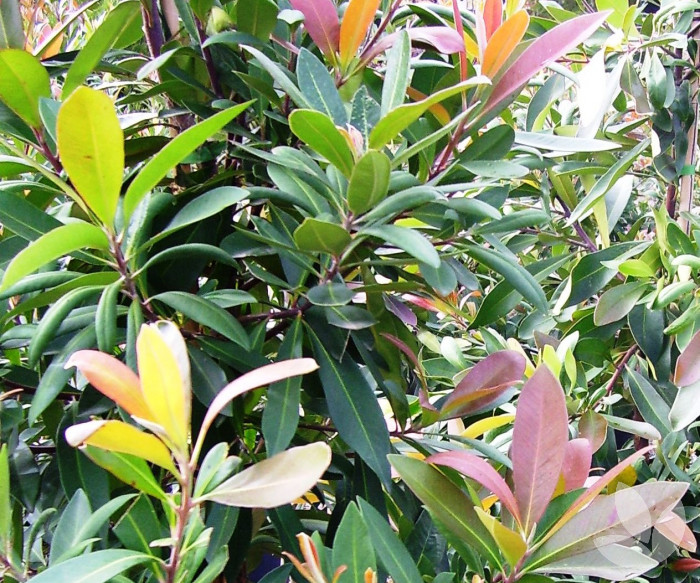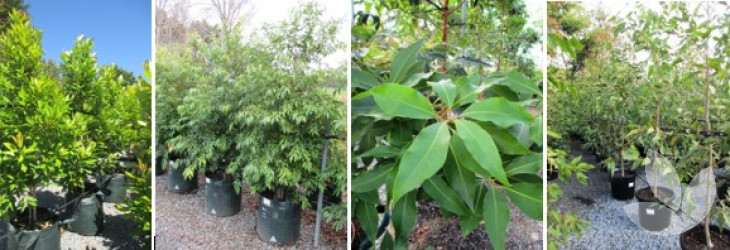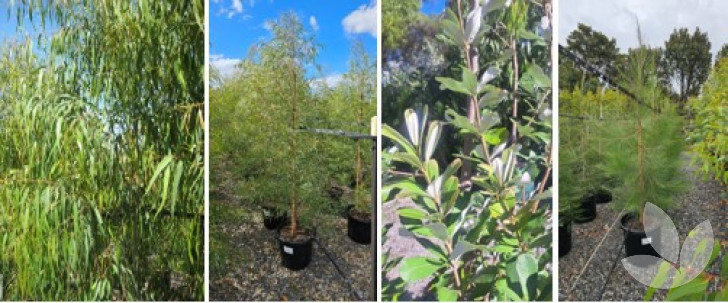Heat Tolerant Versus Drought Tolerant Natives
Due to the hot Australian climate, it is misleading to think that all natives are both heat AND drought-tolerant. That is not the case. Understanding the difference between the two, highlights the importance of selecting landscaping trees to suit the design and planting location.

The difference between drought-tolerant natives and heat-tolerant natives lies in how they manage environmental stress.
Not all natives are the same. Trees that have evolved in a hotter climate will generally handle heat better. While their systems have acclimatised or adapted to withstand higher stress brought on by heat, they may still require adequate moisture to thrive. These adaptations over time include producing lighter coloured foliage and thicker reflective leaf surfaces as a way of preventing overheating.

Natives for Heat Tolerance Left to Right: Tristaniopsis laurina ‘Luscious,’ Waterhousea floribunda ‘Whisper,’ Lophostemon confertus, Corymbia maculata ‘Lowanna’
Native trees such as Tristaniopsis laurina 'Luscious' (Water Gum), Waterhousea floribunda (syn Syzygium floribunda) (Weeping Lilly Pilly), Lophostemon confertus (Queensland Brush Box) and Corymbia maculata (Spotted Gum) have wider leaves and a denser structure. They create a thicker canopy for shade but require moisture for their transpiration system to work effectively.
Similar to how we sweat as humans, water is used to regulate temperature and if too hot, moisture vapour transpires through thousands of little holes in their leaves called stomata, cooling the leaf surface and air around them. Stand beneath these trees on a hot day and it is noticeably cooler.
Consider heat-tolerant trees if you experience hot temperatures in your area, or spasmodic periods of dry but have adequate water supply either via irrigation or rainfall. Heat-tolerant natives are high on Council agendas as they suit plantings in built-up areas, in cities for example, in and around roads and footpaths which attract and absorb heat. These areas are cooled due to the shade and the trees acting as evaporative coolers.
Drought-tolerant trees on the other hand suit planting in drier spaces, hot, dry climates and in areas that are heavily reliant on rainfall for water. Drought-tolerant trees are often those trees used in low-maintenance landscapes. A great example is with the Brachychiton species with its bottle-shaped trunk for water storage.
A tell-tale sign that a native tree is more suited in drought is the presence of smaller and narrower leaves, sometimes waxy, silver or grey in colour which helps to reflect sunlight. These natives are also characterised by deep-root systems with an evolved ability to store water in roots, leaves and stems. The stomata on these types of trees close due to the intense light on hot days, so they don’t transpire as readily. While they will provide shade it is often light shade and with the lack of transpiration, the cooling these trees provide, is less.

Natives for Drought Tolerance: Left to Right: Corymbia citriodora, Eucalyptus Scoparia, Banksia integrifolia, Allocasuarina littoralis
Examples of drought-tolerant trees include Banksia integrifolia (Coastal Banksia) with its waxy leaves, Eucalyptus sideroxylon ‘Rosea’ (Ironbark) with thick bark hence its name, Allocasuarina species (Sheoak) with its fine needle-like leaves, Eucalyptus Scoparia (Wallangarra White Gum) and Corymbia citriodora (Lemon-scented Gum) with its long slender leaves.
For more information on the best native selection for your project, please contact our helpful team.
Receive all the latest news, product information, collections, projects, tips and special offers straight to your inbox each month or so.
Receive all the latest news, product information, collections, projects, tips and special offers straight to your inbox each month or so.
Find a Tree
With more than 400 trees in our library we can help you find the perfect tree for your next project.
Ask a question
We're here to help if you need any advice on selecting the perfect tree for your next project.
Newsletter
Receive all the latest news, product information, collections, projects, tips and special offers straight to your inbox each month or so.
Treefinder can help you identify the perfect tree for your next project!
With over 400 tree varieties for review, the Treefinder app enables you to conveniently browse and compile a list of trees suitable for a number of common landscaping uses - from attracting birds to creating a formal screen or hedge. By selecting desired size, foliage, and a few categories, Treefinder opens up a world of possibilities.
Once you've found the perfect tree you can click through to our website for more information, availability and a quote.

We are specialists in the environmentally sustainable production of premium quality advanced landscaping trees and screens.
For more than 48 years Speciality Trees has been a leader in the production and supply of advanced environmentally sustainable, containerised landscape trees for local government, the landscaping industry and retailers.
Learn more
















